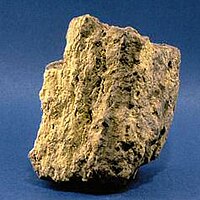
Photo from wikipedia
Abstract We report a series of acidified brine flow-through experiments designed to quantify the coupled alteration of geochemical, structural and fluid transport properties of a Mt. Simon sandstone core recovered… Click to show full abstract
Abstract We report a series of acidified brine flow-through experiments designed to quantify the coupled alteration of geochemical, structural and fluid transport properties of a Mt. Simon sandstone core recovered at a depth of 2110.5 m as part of the Illinois Basin Decatur Project (IBDP). Flow-through experiments were completed at representative in-situ conditions to isolate the stages of initial CO2 injection: first, a single-phase (CO2–saturated brine, Stage 1) followed by a second multi-phase (CO2–saturated brine and supercritical CO2, Stage 2) experiment. During both stages, effluent major and trace cation concentrations were tracked through time. Two imaging methods were employed to analyze the structural alterations of the rock core induced by the percolation of CO2-saturated brine and supercritical CO2: (1) scanning electron microscopy-petrography before Stage 1 and after Stage 2 and (2) computed tomography (CT) scans before and after Stage 2. The time series of Stage 1 effluent solutes were used to constrain a reactive transport simulation of the system. Modeling results suggest the evolution of the solute composition is a result of coupled dissolution of K-feldspar, calcite, illite and pyrite, and precipitation of montmorillonite, mesolite, alunite, diaspore, goethite and muscovite. The model predicted a net opening of pore space and associated increased permeability at the inlet. However, across the whole core, an overall decrease in permeability of approximately 23% ± 0.01 after Stage 1 was determined experimentally. CT analysis confirmed a corresponding decrease in porosity. A comparable permeability decrease was directly measured during Stage 2, concurrent with a decrease in the volume of macro-pores based on multiple CT-resolution methods. In total, this coupled approach demonstrates that geochemical alterations exert a first order control on the evolution of fluid transport properties through time at the earliest stages of in-situ CO2 injection and suggest that chemical dynamics ultimately influence both the magnitude and timing of alterations to the physical integrity of Mt. Simon reservoir over these timescales.
Journal Title: Geochimica et Cosmochimica Acta
Year Published: 2020
Link to full text (if available)
Share on Social Media: Sign Up to like & get
recommendations!